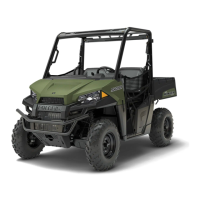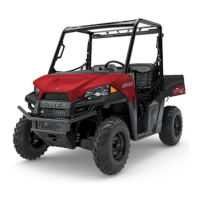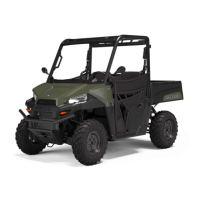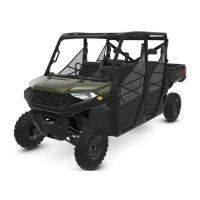Do you have a question about the Polaris RANGER 500 2020 and is the answer not in the manual?
| Brand | Polaris |
|---|---|
| Model | RANGER 500 2020 |
| Category | Offroad Vehicle |
| Language | English |
Information on diagnostic procedures, symptom troubleshooting, and common engine issues like no-start and overheating.
Details maintenance procedures for the engine, including compression tests, oil changes, valve clearance, and breather system checks.
Details engine removal, installation, break-in period, and accessible engine components for service.
Provides information on cooling system overview, specifications, pressure tests, radiator service, thermostat replacement, and bleeding.
Troubleshooting guides for engine issues like spark plug fouling, low power, excessive smoke, and cooling system overheating.
Overview of the ECU, RPM limit function, service procedures, and replacement guidelines.
Details ETC overview, testing, replacement, and the necessary learn procedure after component changes.
Provides instructions for testing the CPS sensor's resistance, wiring, and air gap for proper functionality.
Lists and describes the main components of the EFI system, including fuel pump, rail, lines, filter, injectors, and sensors.
Explains the PVT system's function, components (drive clutch, driven clutch, belt), and general operation.
Covers PVT sealing, guard, and duct components, along with disassembly and assembly procedures for the system.
Guides for diagnosing and resolving common PVT system issues like overheating, belt slippage, and engagement problems.
Steps for removing and installing the front drive shaft, including handling tips for CV joints and boots.
Details on front gearcase removal, installation, assembly views, and AWD operation for both ADC and non-ADC models.
Details on steering assembly views (non-EPS and EPS), steering wheel removal, shaft bearing replacement, and rack removal/installation.
Provides standard and service limit specifications for front and rear brake pads, discs, and runout.
Identifies common causes of brake noise and provides remedies for issues like dirt, dust, or improper pad adjustment.
Lists potential causes for caliper overheating and brake drag, such as plugged ports or incorrect adjustments.
Exploded views of the frame assembly for standard and crew models, detailing components and fasteners.
Details on ignition/headlight switch, AWD/2WD/TURF switch, differential solenoid, and brake pressure switch operation and testing.
Overview of the instrument cluster, rider information display functions, diagnostic mode, and pinouts.
Overview of the differential solenoid's location and function in actuating the rear differential engagement dog.
Steps to verify AWD switch functionality, hub coil voltage, and coil resistance for diagnosing system failures.
Procedure for testing the speed sensor using a static timing light harness and hall sensor probe harness.
Details how to access the diagnostic mode, display trouble codes, and interpret the FMI, SPN, and P-CODE.
Explains how the cooling fan operates via the relay, ECM, and temperature sensor, and the importance of proper coolant level.
Procedure to test the fan control circuit by disconnecting the ECT sensor and checking for fan operation.
Provides a table and illustrations for testing the ignition coil's primary and secondary resistance using a digital multimeter.
Procedure for testing parasitic draw with the key off, identifying causes like accessory wiring and electronic component failures.
Steps for performing a break-even test to determine the point at which the alternator overcomes system loads and charges the battery.
Procedure to measure AC voltage output of stator legs at specified RPMs using a multimeter.
A flowchart to guide the diagnosis of charging system problems, starting with system checks and progressing through meter tests.
Step-by-step guide for activating a new battery, including filling with electrolyte and allowing for absorption.
A flowchart to diagnose starting system issues, guiding through checks for battery, ECU communication, voltage drop, and solenoid tests.












